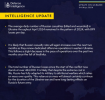Rakastan ryzzän itkua aamuisin! Ihana video, puuttui vain dronen loppusyöksy.
Ja tuohon eivät osu
Install the app
How to install the app on iOS
Follow along with the video below to see how to install our site as a web app on your home screen.
Note: This feature may not be available in some browsers.
You are using an out of date browser. It may not display this or other websites correctly.
You should upgrade or use an alternative browser.
You should upgrade or use an alternative browser.
Ukrainan konflikti/sota
Pitäis noissa isoissa droneissa käyttää semmosia pois tippuvia pyöriä, kuten esmes sakujen me 163 Kometisssa oli... Tulis taas vähän lisää kantamaa ja nopeuttakin.
Ja tuohon eivät osu
Antares
Respected Leader
Tämäkin vahvistaa sitä pitkään jatkunutta kuvitelmaa että erityisesti Kh-101 risteilyohjuksia käytetään ns. kädestä suuhun eli ei ole suuria varastoja vaan uustuotanto menee melkein suoraan Ukrainaa vastaan käytettäväksi.
JOS alla oleva väite pitää paikkansa että tuore pudotettu ohjus oli valmistettu Q2/2024, se tarkoittaisi joko huhtikuuta tai toukokuuta 2024, oletan että todennäköisemmin huhtikuu.
JOS oletetaan että käyttö tapahtuisi pitkälti valmistusjärjestyksessä, niin se voisi tarkoittaa että ryssällä olisi maksimissaan kuukauden, ehkä viiden viikon uustuotannon verran Kh-101 risteilyohjuksia "varastoissa". Aikaisemmin näiden uustuotannoksi arvioitiin 40 kpl per kuukausi mutta tuorein arvio oli 70 kpl. Riippuen sitä, kumpaa käytetään, viiden viikon uustuotanto tarkoittaisi 50 - 87 kpl.
Photo of the serial number on the two-warhead Kh-101 missile seen earlier today. Per Ukrainian outlet Defense Express, the number indicates the Kh-101 was made in Q2 2024. Russia recently changed its system for the Kh-101’s serial number, so I can’t confirm that. But I think it’s probably right. Explanation:
All Kh-101s have a 13-digit serial number on various parts—nose cone, wings, etc. (The number on the engine works a little differently, so we’ll save that aside.)
The first six digits of the serial number still work the same way. All Kh-101 serial numbers start with 315, the production facility code (Raduga Design Bureau). On every Kh-101 I’ve seen that was made after 2020, the next three digits are 263, while the older ones have 648.
Until recently, the seventh digit would be 1 through 4, indicating the quarter, with the eighth digit indicating the year (38 for Q3 2018, 21 for Q2 2021, etc). The next two digits signify the batch number, and the final three digits represent the number within the batch. (I’ve never seen a batch go higher than 20.)
By late 2023, though, the Russians changed the system for the seventh and eight digits. I saw several Kh-101s launched in January-February that had “98” for those digits. In March, there was a Kh-101 whose seventh & eighth digits read “69,” and now this one with “79.”
Defense Express hypothesised that the Russians simply added 5 to the numbers representing the quarter and year. So “98” means Q4 2023, “69” means Q1 2024, and “79” means Q2 2024.
IDK if that’s accurate, but that system would track with when the respective missiles were used. And given that the Russians seem to be living off their monthly missile production, it makes sense that a Kh-101 launched today would have been made in Q2 2024.
https://defence-ua.com/news/rf_dlja...ch_zroblenu_v_2_kvartali_2024_roku-15274.html
https://defence-ua.com/news/rosijan...artali_2023_roku_i_tse_sche_ne_vse-13993.html

JOS alla oleva väite pitää paikkansa että tuore pudotettu ohjus oli valmistettu Q2/2024, se tarkoittaisi joko huhtikuuta tai toukokuuta 2024, oletan että todennäköisemmin huhtikuu.
JOS oletetaan että käyttö tapahtuisi pitkälti valmistusjärjestyksessä, niin se voisi tarkoittaa että ryssällä olisi maksimissaan kuukauden, ehkä viiden viikon uustuotannon verran Kh-101 risteilyohjuksia "varastoissa". Aikaisemmin näiden uustuotannoksi arvioitiin 40 kpl per kuukausi mutta tuorein arvio oli 70 kpl. Riippuen sitä, kumpaa käytetään, viiden viikon uustuotanto tarkoittaisi 50 - 87 kpl.
Photo of the serial number on the two-warhead Kh-101 missile seen earlier today. Per Ukrainian outlet Defense Express, the number indicates the Kh-101 was made in Q2 2024. Russia recently changed its system for the Kh-101’s serial number, so I can’t confirm that. But I think it’s probably right. Explanation:
All Kh-101s have a 13-digit serial number on various parts—nose cone, wings, etc. (The number on the engine works a little differently, so we’ll save that aside.)
The first six digits of the serial number still work the same way. All Kh-101 serial numbers start with 315, the production facility code (Raduga Design Bureau). On every Kh-101 I’ve seen that was made after 2020, the next three digits are 263, while the older ones have 648.
Until recently, the seventh digit would be 1 through 4, indicating the quarter, with the eighth digit indicating the year (38 for Q3 2018, 21 for Q2 2021, etc). The next two digits signify the batch number, and the final three digits represent the number within the batch. (I’ve never seen a batch go higher than 20.)
By late 2023, though, the Russians changed the system for the seventh and eight digits. I saw several Kh-101s launched in January-February that had “98” for those digits. In March, there was a Kh-101 whose seventh & eighth digits read “69,” and now this one with “79.”
Defense Express hypothesised that the Russians simply added 5 to the numbers representing the quarter and year. So “98” means Q4 2023, “69” means Q1 2024, and “79” means Q2 2024.
IDK if that’s accurate, but that system would track with when the respective missiles were used. And given that the Russians seem to be living off their monthly missile production, it makes sense that a Kh-101 launched today would have been made in Q2 2024.
https://defence-ua.com/news/rf_dlja...ch_zroblenu_v_2_kvartali_2024_roku-15274.html
https://defence-ua.com/news/rosijan...artali_2023_roku_i_tse_sche_ne_vse-13993.html

Harvapartio
Eversti
Avdiivkan suunnalla olisi pudonnut Su-25.
Antares
Respected Leader
High_marsed pohdiskelee ryssän aktiivijoukkojen vaunumäärällä ja mahdollisella koostumuksella:
Assuming a production rate of 60 per year for 2022/2023 and ~90 per year for 2024, as well as a pre war number of 67 and 89 losses Russia likely has about 126 active T-90M.
I think this number is realistic but the biggest question here is how many of them are upgraded T-90/A.
Here is a source that suggests that production has increased to 10-11 every six months or ~90 per year. (HUOM: hän vahvistaa kommenteissa että tarkoitus oli kirjoittaa 10-11 kpl kuuden viikon välein)
Also an image showing Russia likely had some T-90 Obr. 1992 in storage.
https://bulgarianmilitary.com/2024/...ad-of-t-90m-proryv-tanks-to-the-russian-army/
On May 6, a train laden with T-90M Proryv tanks left the premises of the Nizhny Tagil Tank Plant, heading for the Russian military, as confirmed by the plant’s media representatives. Although the exact number of tanks is unreported, this shipment follows closely behind a new batch of T-72B3M tanks sent just one week earlier.
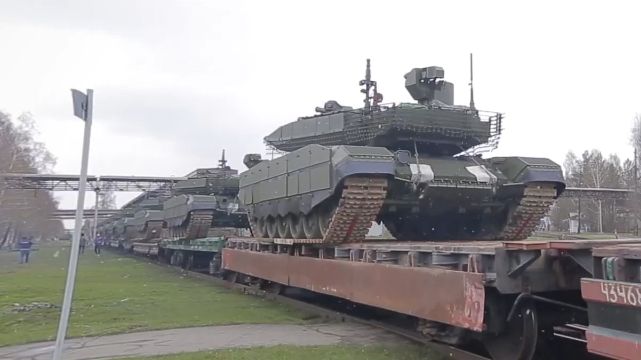
Video screenshot
“The unrelenting work of the dedicated team at Nizhny Tagil plant ensures a steady supply of advanced military tech to our forces, adeptly meeting deadlines and maintaining high-quality production for state defense orders. Efficiency and speed are the backbone of our operation, leading to a steadily increasing monthly production of armored vehicles. Furthermore, we are consistently motivated to improve the tactical-technical features of these machines. Currently, the spotlight is on our team at Uralvagonzavod as they take on the exciting challenge of incorporating technological innovations into our combat vehicles,” stated the dedicated staff at Nizhny Tagil.
In a recent post on the Russian social network, VKontakte, Uralvagonzavod revealed a brief but informative video showcasing the meticulous testing and production processes of the T-90M Proryv. The footage concludes with a panoramic view of the tanks, proudly stationed on the train, ready for departure. The video suggests an estimate of 10-11 T-90M tanks aboard the train, through careful observation.
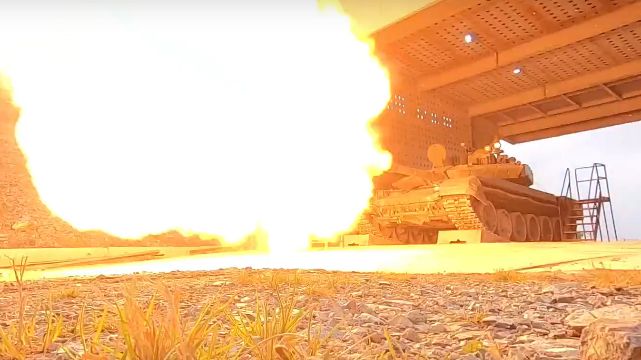
Video screenshot
It’s worth noting that just six weeks ago [on March 12], the Russian army received its most recent delivery of T-90M Proryv tanks. A train filled with these formidable machines departed from the Uralvagonzavod railway depot. The occasion was marked with fanfare, including a grand musical performance at the plant yard, Uralvagonzavod management’s way of showing appreciation for its team.
Providing some context to this latest delivery, Uralvagonzavod shares a fascinating note: “It’s incredibly symbolic that our most recent delivery of the globally acclaimed T-90M Proryv tanks to the Russian army occurred on the eve of the prestigious Victory Day. May 9 holds a special place in the hearts of everyone at the Uralvagonzavod enterprises. Our facilities, which became tank-manufacturing hubs following the extensive evacuation of defense plants from the west to the east of the Soviet Union during the onset of the war, made an invaluable contribution to the war effort.”

Video screenshot
“In today’s world, our beloved Motherland faces numerous external threats. We steadfastly defend Russia’s sovereignty and strongly oppose neo-Nazi ideologies. Today, like their predecessors 80 years ago, Uralvagonzavod’s employees are producing the finest military equipment of our time. They have proven their worth again and again, demonstrating that they are indeed worthy successors to our generation of victors,” shares Alexander Potapov, the Chief Executive Officer of Uralvagonzavod.
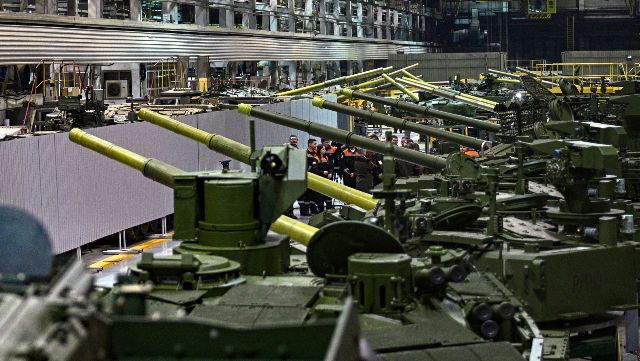
Photo by Samil Ritdikov
As sources, including the British MoD intelligence, repeatedly highlight Russia’s impressive tank production and repair capabilities, it’s clear that the country maintains a formidable pace. These reports suggest that Russia’s military losses can be easily offset by robust domestic production. The real question that emerges is whether Russia’s monthly supply consists of brand new tanks, or if it’s merely a rotation of refurbished machines from reserves.
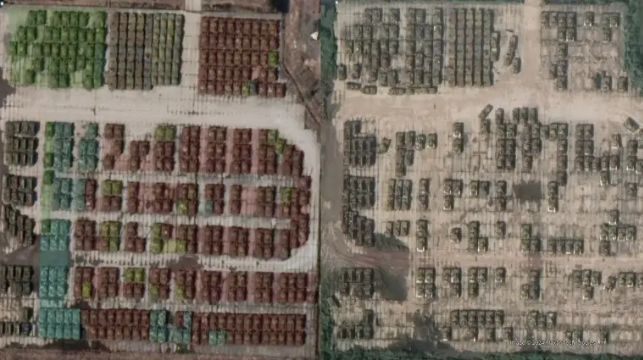
Photo credit: Reddit
Experts raise questions regarding the sustainability of this utilization rate in compensating for current losses and ponder if it can continue through 2023 and early 2024. They speculate that this trend might indicate a peak in reservoir renovation and replenishment efforts. To stress their point, they note that the rate of this so-called deconservation process has slowed compared to earlier years. This slowing pace, they believe, is primarily due to the declining quality of the equipment being worked on.
Evidence of a bottleneck at major armor production facilities is being noted by analysts. They see this as a sign of the immense pressure these facilities are under. It’s quite worrisome that nearly 95% of the primary reserve sites are filled to their maximum capacity, as indicated by expert analysis. This implies that approximately 3,150 tanks at the central bases of the reserves, along with roughly 1,300-1,500 tanks in peripheral reserves and near the main tank remodeling workshops, could be suitable for deconservation and refurbishment.
However, amidst these computations, experts acknowledge the inconsistent and often questionable technical condition of the 3,150 tanks stationed at these bases. They underscore the omission of tanks with missing turrets or those discarded in areas where they have largely been dismantled for spare parts, rendering them of little value, even as a source of replacement parts. Of all these forsaken tanks, those from the 1311th base seem to have the highest potential for recovery.
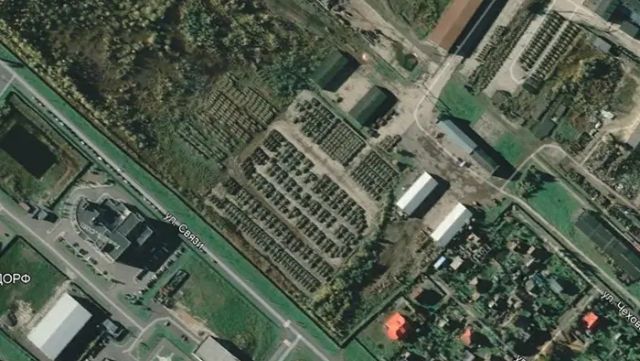
Photo credit: Drukaria
The T-90M Proryv, also known as ‘Breakthrough,’ is a modernized version of the T-90 main battle tank developed by Russia. This formidable piece of military technology is designed for all-weather, day-night combat operations, featuring enhanced firepower, mobility, and protection.
With dimensions of approximately measuring 9.53 meters in length, 3.78 meters in width, and 2.22 meters in height, the T-90M Proryv boasts a combat weight of about 48 tons. The tank is structured to accommodate a crew of three: a commander, a gunner, and a driver.
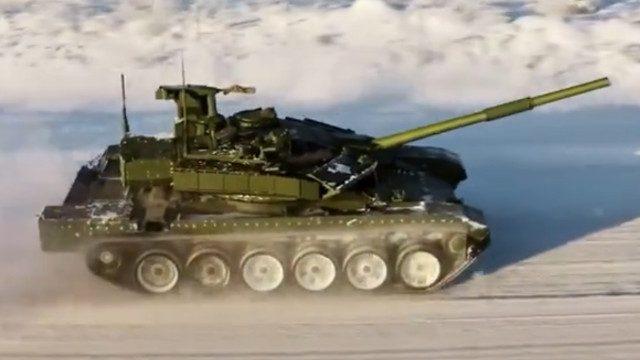
Video screenshot
Under the hood, the tank is powered by a V-92S2F engine that provides 1130 horsepower, enabling the T-90M to reach a top speed of 60 km/h on the road and 45 km/h off-road. Not to mention, the tank also features a torsion bar suspension system, ensuring a smooth ride across rough terrain.
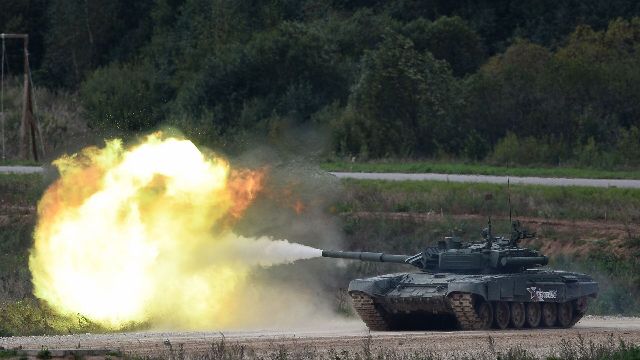
Photo by Maksim Blinov / Sputnik
The fire control system of the T-90M is highly advanced, featuring a 1A45T Irtysh ballistic computer, a gunner’s sight with thermal imaging, and a commander’s panoramic sight with thermal imaging. This allows for accurate target acquisition and engagement in all weather conditions, day or night.
The operational range of the projectiles used by the T-90M varies depending on the type of ammunition. The APFSDS rounds can reach up to 4,000 meters, the HEAT rounds up to 5,000 meters, and the HE-FRAG rounds up to 4,000 meters. The 9M119M Refleks anti-tank guided missiles have a maximum range of 5,000 meters.
***
Follow us everywhere and at any time. BulgarianMilitary.com has responsive design and you can open the page from any computer, mobile devices or web browsers. For more up-to-date news, follow our Google News, YouTube, Reddit, LinkedIn, Twitter and Facebook pages. Our standards: Manifesto & ethical principles.
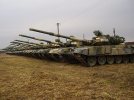
Based on that I would suggest the following numbers as a guess for the active Russian tank fleet.
The total number is based on the MB2024.
Keep in mind I just made up these numbers based on my perception and they could be completely wrong.
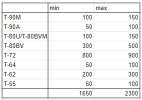
-
Lainaan alle muutaman ketjuun tulleen kommentin.
Kommentti: I think the T-90A number is an overestimate considering their rare sight in loss figures
Johon high_marsed vastasi näin: I agree that 100 might be to high, but 50 T-90A/S is not unrealistic in my opinion.
Johon alkuperäisen kommentin esittäjä vastasi näin: Yeah I would have guessed something between 30 and 70 as well
-
Kommentti: Which is quite significantly lower than the number they had in active service at the beginning of full-scale invasion, which was around 3 000 tanks.
Johon high_marsed vastasi näin: I am using the total number of active tanks presented by the Military Balance and if I remember correctly RUSI also estimates that they have about ~2000 active tanks. These numbers could be wrong but they are likely the best estimates we have
-
Kommentti: acc. to colonel Mashovets the q-ty of ru tanks deployed in UA (tanks deployed in ru are not included) was:
24.04.2023 = 1764
10.10.2023 = 2347
31.10.2023 = 2324
01.02.24 = 2797
His source is unknown, most likely that this is the info from UA intelligence
https://www.facebook.com/pashtetof
-
Minun kommentti: tuo bulgarianmilitary.com nettisivu on omituinen tapaus, tosin toisinaan olen lainannut heidän kirjoituksiaan tähän ketjuun kun niitä on tullut vastaan ns. mielenkiintoisista aiheista.
Vaikea silti ottaa todesta kaikkea mitä kirjoittavat, joten paras olla varovainen heidän kanssaan.
Mielenkiintoisia numeroita myös tällä eversti Mashovetsilla, niiden mukaan aikavälillä 24.4.2023 - 1.2.2024 eli reilussa yhdeksässä kuukaudessa ryssä olisi kyennyt kasvattamaan Ukrainassa olevien panssarivaunujen määrää reilulla tuhannella eli 1 764 --> 2 797
Tämä siis viime kuukausien kasvaneista tappioista huolimatta, tosin on muistettava, että tämän kaltaisten arvioiden lähteistä ei voida olla varmoja. Muistan jonkun kommentoineen aikaisemmin että tällaiset arviot ovat mahdollisesti "Ukrainaan saapuneiden panssarivaunujen määrä" eli niin kauan kuin vaunut eivät poistu Ukrainan alueelta, ne lasketaan osaksi kokonaisuutta. Täten numerossa ei siis oteta huomioon panssarivaunun kuntoa vaan ainoastaan pidetään kirjaa vaunuista Ukrainan alueella.
Toisaalta uskon itsekin että ryssän kasvanut into hyökätä kertoo osaksi siitä että heillä on Ukrainassa kalustoa siinä määrin että rohkenevat hyökätä. Mikä tarkoittaisi että myös panssarivaunuja on "riittävästi". Jos niitä olisi vähän, he eivät tohtisi hyökätä.
Assuming a production rate of 60 per year for 2022/2023 and ~90 per year for 2024, as well as a pre war number of 67 and 89 losses Russia likely has about 126 active T-90M.
I think this number is realistic but the biggest question here is how many of them are upgraded T-90/A.
Here is a source that suggests that production has increased to 10-11 every six months or ~90 per year. (HUOM: hän vahvistaa kommenteissa että tarkoitus oli kirjoittaa 10-11 kpl kuuden viikon välein)
Also an image showing Russia likely had some T-90 Obr. 1992 in storage.
https://bulgarianmilitary.com/2024/...ad-of-t-90m-proryv-tanks-to-the-russian-army/
UVZ sent one trainload of T-90M Proryv tanks to the Russian Army
By Boyko Nikolov On May 6, 2024On May 6, a train laden with T-90M Proryv tanks left the premises of the Nizhny Tagil Tank Plant, heading for the Russian military, as confirmed by the plant’s media representatives. Although the exact number of tanks is unreported, this shipment follows closely behind a new batch of T-72B3M tanks sent just one week earlier.

Video screenshot
“The unrelenting work of the dedicated team at Nizhny Tagil plant ensures a steady supply of advanced military tech to our forces, adeptly meeting deadlines and maintaining high-quality production for state defense orders. Efficiency and speed are the backbone of our operation, leading to a steadily increasing monthly production of armored vehicles. Furthermore, we are consistently motivated to improve the tactical-technical features of these machines. Currently, the spotlight is on our team at Uralvagonzavod as they take on the exciting challenge of incorporating technological innovations into our combat vehicles,” stated the dedicated staff at Nizhny Tagil.
In a recent post on the Russian social network, VKontakte, Uralvagonzavod revealed a brief but informative video showcasing the meticulous testing and production processes of the T-90M Proryv. The footage concludes with a panoramic view of the tanks, proudly stationed on the train, ready for departure. The video suggests an estimate of 10-11 T-90M tanks aboard the train, through careful observation.

Video screenshot
The last T-90M batch was in March
It’s worth noting that just six weeks ago [on March 12], the Russian army received its most recent delivery of T-90M Proryv tanks. A train filled with these formidable machines departed from the Uralvagonzavod railway depot. The occasion was marked with fanfare, including a grand musical performance at the plant yard, Uralvagonzavod management’s way of showing appreciation for its team.
Providing some context to this latest delivery, Uralvagonzavod shares a fascinating note: “It’s incredibly symbolic that our most recent delivery of the globally acclaimed T-90M Proryv tanks to the Russian army occurred on the eve of the prestigious Victory Day. May 9 holds a special place in the hearts of everyone at the Uralvagonzavod enterprises. Our facilities, which became tank-manufacturing hubs following the extensive evacuation of defense plants from the west to the east of the Soviet Union during the onset of the war, made an invaluable contribution to the war effort.”

Video screenshot
“In today’s world, our beloved Motherland faces numerous external threats. We steadfastly defend Russia’s sovereignty and strongly oppose neo-Nazi ideologies. Today, like their predecessors 80 years ago, Uralvagonzavod’s employees are producing the finest military equipment of our time. They have proven their worth again and again, demonstrating that they are indeed worthy successors to our generation of victors,” shares Alexander Potapov, the Chief Executive Officer of Uralvagonzavod.
High rate of tank production
In the early stages of the conflict between Ukraine and Russia, T-90M tanks were a rare sight at the frontline. However, with time, Moscow ramped up production for these formidable war machines. Nowadays, the exclusive production of these tanks has been relegated to Uralvagonzavod, while other tank-making enterprises, such as the Omsk Machine-Building Plant, have taken up the task of refurbishing tanks returned from battle.
Photo by Samil Ritdikov
As sources, including the British MoD intelligence, repeatedly highlight Russia’s impressive tank production and repair capabilities, it’s clear that the country maintains a formidable pace. These reports suggest that Russia’s military losses can be easily offset by robust domestic production. The real question that emerges is whether Russia’s monthly supply consists of brand new tanks, or if it’s merely a rotation of refurbished machines from reserves.
Discrepancy in data
Reports suggesting that Russia produces 100 tanks per month have been challenged by Ukrainian sources. These sources propose that there might be confusion between the terms “production” and “renovation of preserved tanks.” In support of their argument, they refer to satellite imagery showing nearly 400 tanks disappearing from Russia’s primary tank reserves over 5-7 months. Experts from Resurgam, Military Seer, and Mortis Aeterna have observed a monthly reduction of 44-75 units in these reserves.
Photo credit: Reddit
Experts raise questions regarding the sustainability of this utilization rate in compensating for current losses and ponder if it can continue through 2023 and early 2024. They speculate that this trend might indicate a peak in reservoir renovation and replenishment efforts. To stress their point, they note that the rate of this so-called deconservation process has slowed compared to earlier years. This slowing pace, they believe, is primarily due to the declining quality of the equipment being worked on.
Evidence of a bottleneck at major armor production facilities is being noted by analysts. They see this as a sign of the immense pressure these facilities are under. It’s quite worrisome that nearly 95% of the primary reserve sites are filled to their maximum capacity, as indicated by expert analysis. This implies that approximately 3,150 tanks at the central bases of the reserves, along with roughly 1,300-1,500 tanks in peripheral reserves and near the main tank remodeling workshops, could be suitable for deconservation and refurbishment.
However, amidst these computations, experts acknowledge the inconsistent and often questionable technical condition of the 3,150 tanks stationed at these bases. They underscore the omission of tanks with missing turrets or those discarded in areas where they have largely been dismantled for spare parts, rendering them of little value, even as a source of replacement parts. Of all these forsaken tanks, those from the 1311th base seem to have the highest potential for recovery.

Photo credit: Drukaria
The Breakthrough
The T-90M Proryv, also known as ‘Breakthrough,’ is a modernized version of the T-90 main battle tank developed by Russia. This formidable piece of military technology is designed for all-weather, day-night combat operations, featuring enhanced firepower, mobility, and protection.
With dimensions of approximately measuring 9.53 meters in length, 3.78 meters in width, and 2.22 meters in height, the T-90M Proryv boasts a combat weight of about 48 tons. The tank is structured to accommodate a crew of three: a commander, a gunner, and a driver.

Video screenshot
Under the hood, the tank is powered by a V-92S2F engine that provides 1130 horsepower, enabling the T-90M to reach a top speed of 60 km/h on the road and 45 km/h off-road. Not to mention, the tank also features a torsion bar suspension system, ensuring a smooth ride across rough terrain.
125mm smoothbore gun
The T-90M’s main gun is a 125mm 2A46M-5 smoothbore gun, capable of firing a variety of ammunition types, including APFSDS, HEAT, and HE-FRAG. It also can launch 9M119M Refleks [AT-11 Sniper] anti-tank guided missiles. The secondary armament of the T-90M includes a 7.62mm PKTM machine gun and a 12.7mm Kord heavy machine gun. The tank is also equipped with an automatic grenade launcher.
Photo by Maksim Blinov / Sputnik
The fire control system of the T-90M is highly advanced, featuring a 1A45T Irtysh ballistic computer, a gunner’s sight with thermal imaging, and a commander’s panoramic sight with thermal imaging. This allows for accurate target acquisition and engagement in all weather conditions, day or night.
The operational range of the projectiles used by the T-90M varies depending on the type of ammunition. The APFSDS rounds can reach up to 4,000 meters, the HEAT rounds up to 5,000 meters, and the HE-FRAG rounds up to 4,000 meters. The 9M119M Refleks anti-tank guided missiles have a maximum range of 5,000 meters.
***
Follow us everywhere and at any time. BulgarianMilitary.com has responsive design and you can open the page from any computer, mobile devices or web browsers. For more up-to-date news, follow our Google News, YouTube, Reddit, LinkedIn, Twitter and Facebook pages. Our standards: Manifesto & ethical principles.

Based on that I would suggest the following numbers as a guess for the active Russian tank fleet.
The total number is based on the MB2024.
Keep in mind I just made up these numbers based on my perception and they could be completely wrong.

-
Lainaan alle muutaman ketjuun tulleen kommentin.
Kommentti: I think the T-90A number is an overestimate considering their rare sight in loss figures
Johon high_marsed vastasi näin: I agree that 100 might be to high, but 50 T-90A/S is not unrealistic in my opinion.
Johon alkuperäisen kommentin esittäjä vastasi näin: Yeah I would have guessed something between 30 and 70 as well
-
Kommentti: Which is quite significantly lower than the number they had in active service at the beginning of full-scale invasion, which was around 3 000 tanks.
Johon high_marsed vastasi näin: I am using the total number of active tanks presented by the Military Balance and if I remember correctly RUSI also estimates that they have about ~2000 active tanks. These numbers could be wrong but they are likely the best estimates we have
-
Kommentti: acc. to colonel Mashovets the q-ty of ru tanks deployed in UA (tanks deployed in ru are not included) was:
24.04.2023 = 1764
10.10.2023 = 2347
31.10.2023 = 2324
01.02.24 = 2797
His source is unknown, most likely that this is the info from UA intelligence
https://www.facebook.com/pashtetof
-
Minun kommentti: tuo bulgarianmilitary.com nettisivu on omituinen tapaus, tosin toisinaan olen lainannut heidän kirjoituksiaan tähän ketjuun kun niitä on tullut vastaan ns. mielenkiintoisista aiheista.
Vaikea silti ottaa todesta kaikkea mitä kirjoittavat, joten paras olla varovainen heidän kanssaan.
Mielenkiintoisia numeroita myös tällä eversti Mashovetsilla, niiden mukaan aikavälillä 24.4.2023 - 1.2.2024 eli reilussa yhdeksässä kuukaudessa ryssä olisi kyennyt kasvattamaan Ukrainassa olevien panssarivaunujen määrää reilulla tuhannella eli 1 764 --> 2 797
Tämä siis viime kuukausien kasvaneista tappioista huolimatta, tosin on muistettava, että tämän kaltaisten arvioiden lähteistä ei voida olla varmoja. Muistan jonkun kommentoineen aikaisemmin että tällaiset arviot ovat mahdollisesti "Ukrainaan saapuneiden panssarivaunujen määrä" eli niin kauan kuin vaunut eivät poistu Ukrainan alueelta, ne lasketaan osaksi kokonaisuutta. Täten numerossa ei siis oteta huomioon panssarivaunun kuntoa vaan ainoastaan pidetään kirjaa vaunuista Ukrainan alueella.
Toisaalta uskon itsekin että ryssän kasvanut into hyökätä kertoo osaksi siitä että heillä on Ukrainassa kalustoa siinä määrin että rohkenevat hyökätä. Mikä tarkoittaisi että myös panssarivaunuja on "riittävästi". Jos niitä olisi vähän, he eivät tohtisi hyökätä.
Viimeksi muokattu:
rty19
Greatest Leader
Puola luovuttanut kaikki S-200V IT-järjestelmänsä Ukrainalle
Zelensky ja Porosenko poistettu Venäjän wanted- listalta, mihin ne lisättiin vaan muutama päivä sitten.
Vitsailua syystä:
Vitsailua syystä:
Nyt EU on päättäny, että Venäjän jäädytetyistä varoista saaduista voitoista kerätyt verot käytetään Ukrainan hyväksi, 90% menee aseelliseen apuun.
Viimeksi muokattu:
Ei vaan mielestäni tuossa lukee jäädytettyjen varojen voitoista kerätyt verot. Eli tuossa ei oteta ryssältä yhtään mitään vaan Belgia luovuttaa varoista saamansa hyödyn/verotulot Ukrainalle.Nyt EU on päättäny, että Venäjän jäädytetyistä varoista saadut voitot
Muok. Ja päätöstä ei tehnyt EU vaan Belgia tuolla kompensoi EU:n auttamishaluttomien valtioiden tuen aiheuttamaa vajetta.
Lahtinen
Majuri
Näillä rahoilla Venäjä sotii ja jatkaa sotimista , lainaus :
" Viime vuoden alusta laskien EU-maat ovat ostaneet Venäjän fossiilienergiaa
ja rahoittaneet Putinin sotataloutta – yhteensä runsaalla 40 miljardilla eurolla.
Samaan aikaan ja samaan tarkoitukseen Kiina on käyttänyt yli 120 miljardia, Intia noin 60 miljardia ja Turkki vajaat 45 miljardia euroa.
Kaikkiaan maailman maat ovat ostaneet hyökkäyssodan alkamisen jälkeen Venäjän fossiilienergiaa lähemmäs 680 miljardin euron arvosta.
Ei ihme, että Putinin sotatalous pysyy käynnissä. "
Taisi jäädä se olennainen lainaamatta:
"Mutta pian hyökkäyssodan alkamisen jälkeen EU-maat ryhtyivät yhdessä Yhdysvaltain ja muiden länsimaiden kanssa asettamaan Venäjälle monenlaisia talouspakotteita, joita vähin erin ulotettiin myös energia-alalle.
EU-maiden onnistui yllättävän nopeasti vähentää energiaostojaan Venäjältä ja siirtää hankintojaan esimerkiksi Lähi-itään.
Crean tilastojen mukaan energiakaupan rahavirta EU-maista Venäjälle ehtyi viime vuoden huhtikuuhun mennessä noin kymmenesosaan hyökkäyssodan alkuaikojen lukemista."
Eli, menot ovat räjähtäneet käsiin ja suurin energian ostaja on tiputtanut ostoja 90 prosenttia. Joten, ei tuo nyt kovin hyvältä kuulosta millään mittarilla. Ja kuten täällä on monta kertaa tuotu esille, niin tuo energiakauppa Intian ja Kiinan kanssa on venäjälle äärimmäisen epäedullista verrattuna kauppaan EU:n kanssa, sekä määrällisesti aivan liian pientä, jotta se pystyisi sen korvaamaan.
Venom_Snake
Luutnantti
Ja kaasun ja öljyn kuljetukseen vaadittava infra, jolla kuljettaa myyty sama määrä energiaa Kiinaan tai Intiaan (jota Eurooppaan on myyty), olisi kallis ja aikaa vievä rakentaa.Eli, menot ovat räjähtäneet käsiin ja suurin energian ostaja on tiputtanut ostoja 90 prosenttia. Joten, ei tuo nyt kovin hyvältä kuulosta millään mittarilla. Ja kuten täällä on monta kertaa tuotu esille, niin tuo energiakauppa Intian ja Kiinan kanssa on venäjälle äärimmäisen epäedullista verrattuna kauppaan EU:n kanssa, sekä määrällisesti aivan liian pientä, jotta se pystyisi sen korvaamaan.
WardLittell
Majuri

Pääkirjoitus: Voitonpäivän uho jäi vaisuksi Moskovassa – Putinin odottama lahja rintamalta jäi saamatta
Presidentti Vladimir Putinin viidennestä virkakaudesta on tulossa hänen poliittisen uransa vaikein.
"PUTININ EDESSÄ on todennäköisesti hänen vaikein virkakautensa. Venäjän miehistö- ja kalustotappiot Ukrainassa ovat valtavia. Sotatalouteen ajettu liittovaltio upottaa puolustukseen ja turvallisuuteen jo kolmanneksen federaatiobudjetista. Toistaiseksi Venäjällä on siihen varaa, mutta kuinka kauan?
Yhdysvaltain Euroopan-joukkojen entinen komentaja, kenraaliluutnantti Ben Hodges kehottaa länttä ryhtymään aktiivisiin toimiin hallinnon vaihtamiseksi Moskovassa – pelkäämättä valtataistelusta syntyvää kaaosta. Paras keino siihen on Ukrainan auttaminen selkeään voittoon puolustussodassa. Kuka olisi pahempi kuin Putin, kenraali on kysynyt.
Hodges on oikeilla jäljillä. Putinin seuraajan olisi pakko keskittyä sisäisen järjestyksen palauttamiseen, asemansa vahvistamiseen ja sodan aiheuttamien menetysten korvaamiseen. Näin Venäjän lähialueilleen kohdistama uhka väistyisi, ja Venäjästä voisi vähitellen tulla normaaliin yhteistyöhön kykenevä naapuri.
Vielä nyt Venäjän ja Ukrainan tulevaisuus on kuitenkin hämärän peitossa. Siksi kaikkeen pitää varautua, myös pahimpaan."
J0h1F
Respected Leader
Niin, näinhän Mannerheim-linjakin murrettiin. Hyökkäyksiä aalto aallon perään ja tykistötulta jatkuvasti, ja niin se lopulta murtui.Ei se Venäjän pointti varmaan ookkaan siinä, että hivutettais vastaavaa tahtia loputtomiin, vaan siinä, että tätä menoa joku päivä Ukrainan rintama romahtaa ja sitten mennäänkin vauhdilla.
Ja myös itse artikkeli arkistolinkin takana luettavissa:Venäjän kaasuliiketoiminta ei koskaan toivu Ukrainan sodasta
Ennen sodan alkua venäjä vei eurooppaan 180 miljardia kuutiota maakaasua, mikä vastasi 80% kaasun kokonaistuotannosta. Nyt vientikauppa on seis ja se ei ole tulossa takaisin. Nordstreamin kapasiteetille ei ole korvaajaa toiselle markkina-alueelle minne vienti olisi mahdollista. Kiinan kanssa ollut keskusteluja uuden putkilinjan rakentamisesta, mutta kiina ei ole valmis vastaamaan kustannuksista. Vaikka sota joskus päättyykin, on nordstreamin kunto ja jälleenrakentaminen tällä hetkellä epäselvää. Lisäksi Eurooppalaiset ovat siirtyneet ostamaan tarvitsemansa kaasun pääosin jenkeiltä.
Venäjän kaasun kuljettaminen laivoilla ei ole vaihtoehto, sillä LNG:n tuotanto edellyttää nesteytyksessä lämpötilan laskua alle -160 celsiuksen, mikä venäjältä ei isommassa mittakaavassa onnistu.
Vaikka kaasutulot ovat muuttuneet tappioiksi niin kaasun osuus viedyistä hiilivedyistä oli ennen sotaa 20% joten öljymyynnillä venäjä pystyy vielä ylläpitämään talouttaan.

Russia’s gas business will never recover from the war in Ukraine
Hopes of a Chinese rescue look increasingly vainwww.economist.com
The Economistin juttu on maksumuurin takana, mutta tässä lyhyt artikkeli suomeksi
Edes Euroopan ihmisoikeussopimus tai EU:n perussopimus eivät olisi tätä vastaan, mutta jos maa on mukana Euroopan ihmisoikeussopimuksen 13. lisäpöytäkirjassa, niin se on esteenä (siinä on kuolemanrangaistuksen täyskielto).Minusta sotatilanteessa tuollaiset kaverit voisi laittaa seinää vasten. Oli Amnesty tai muut rauhanliitot mitä mieltä tahansa. Mikä järki laittaa maanpetturit vankilaan kytemään ja joskus kun vapaus koittaa toteuttamaan itseään ehkä erilaisessa ilmapiirissä?
En ole kuolemantuomion kannalla muuten, mutta kaikkein törkeimmät maanpetturit vaan monttuun tai "vapaaehtoisesti" miinanraivaajaksi.
Ei, maanpetturuus on juuri sellainen rikos, jossa se on erittäin sopiva tie.Kuolemanrangaistus on tietyissä rikoksissa liian helppo tie....
Kreikka tai Turkki myös mahdollinen.Olisiko M106 kranaattia joko jenkeistä tai koreasta?
M-30 voi käyttää samaa kranaattia kuin D-30 ja 2S1, eli OF-462 (joka alun perin suunniteltiin sille), mutta kartussi on erilainen. D-30 ja 2S1 käyttävät 122x447mmR, kun taas M-30 122x284mmR.As you can see half of the remaining guns are 122mm M-30 which was one of the main artillery pieces of the red army during WW2. They are likely mostly useless today, since they probably shouldn't use modern ammunition, although Russia might have some old ammunition in storage.
Additionally it is possible that some of the remaining guns are not usable, since they have been in storage for a long time, although it is not possible to accurately asses the effects of that in the satelite footage. Cannibalization is also possible.
If I had to make a prediction I would guess that likely most of the remaining D-30s, MT-12 and D-1/D-20 will be removed during 2024 and leave behind about 400 units mostly consisting of M-30s that wont be removed at all.
Todennäköisesti tulemme näkemään myös noiden käyttöönoton, jos kulutus jatkuu tällä tasolla. Eiköhän noita hylsyjä ole kuitenkin jossain (ja valmistus lienee kuitenkin triviaalista, jos ei jopa pidemmistä uusista typistämällä onnistu), ja ryssän panostuotanto on todennäköisesti riittävällä tasolla noiden suhteellisen vähän ruutia kuluttavien kartussien lataamiseen.
Kyllä noissa on ihan selvästi Sosna-U, eli ovat T-80BVM. Jonkin verran kalustoa lienee jätetty varuskuntaan.Kuva Murmanskin paraatista, siellä on ollut muutama T-80BVM panssarivaunu (vai ovatko T-80BV obr 2022 - vaikea sanoa, näiden erot ovat pieniä ja osaksi hiusten halkomista, vaikka toki vaunumallien välillä on aitoja eroja suorituskyvyssä mm. erilaisen ampujan lämpötähtäimen takia):
[May 9] Murmansk, a military parade took place with the participation of the forces and troops of the Northern Fleet. Crew of Prince Pozharsky. 403rd Mixed Separate Guards. 98th mixed aviation regiment. 61st Marine Brigade. 80th motorized rifle brigade. The T-34
Katso liite: 97335
Maidan
Respected Leader
Tänään Ukrainan puolustusvoimat tekivät ennätyksen Venäjän alueella sijaitsevaan kohteeseen osumisen kantaman suhteen. SBU-drooni lensi noin 1 500 kilometriä osuen öljyn katalyyttiseen krakkauslaitteistoon öljynjalostamolla Bashkortostanissa.
On myös tärkeää, että tämä yritys - Gazprom Neftekhim Salavat - on yksi Venäjän suurimmista öljynjalostuksen ja petrokemian alalla. Jalostamo on erikoistunut bensiinin, dieselpolttoaineen ja muiden öljytuotteiden tuotantoon.
Se, että Ukraina ei kuunnellut virkamiesten puheluita Yhdysvalloissa, jonka likinäköisyys rikkoo myös ennätyksiä, ei voi muuta kuin iloita. Kiova jatkaa menetelmällisesti Putinin joukkojen öljynjalostuksen ja polttoaineen toimituslogistiikan tuhoamista, mikä on yksi harvoista Ukrainan tehokkaan puolustuksen menetelmistä.



Mutta dronithan eivät olleet kiellossa, vai onko niitäkin joku yrittänyt kieltää?
On myös tärkeää, että tämä yritys - Gazprom Neftekhim Salavat - on yksi Venäjän suurimmista öljynjalostuksen ja petrokemian alalla. Jalostamo on erikoistunut bensiinin, dieselpolttoaineen ja muiden öljytuotteiden tuotantoon.
Se, että Ukraina ei kuunnellut virkamiesten puheluita Yhdysvalloissa, jonka likinäköisyys rikkoo myös ennätyksiä, ei voi muuta kuin iloita. Kiova jatkaa menetelmällisesti Putinin joukkojen öljynjalostuksen ja polttoaineen toimituslogistiikan tuhoamista, mikä on yksi harvoista Ukrainan tehokkaan puolustuksen menetelmistä.



Mutta dronithan eivät olleet kiellossa, vai onko niitäkin joku yrittänyt kieltää?
Viimeksi muokattu:
Harvapartio
Eversti
Pentagonista sanotaan että ovat onnistuneet SpaceX:n kanssa estämään venäläisten Starlinkin käytön ja hyödyntämisen ilman että se vaikuttaa ukrainalaisten käyttöön.

